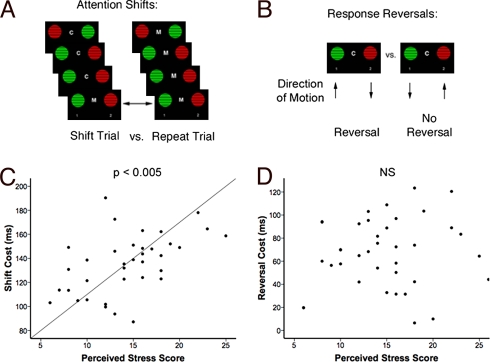Fig. 1.
Chronic psychosocial stress selectively impaired attention shifting. (A) Attention-shift paradigm. Subjects viewed two moving, circular square-wave gratings on each trial and were cued to respond on the basis of either the color (“C”) or the motion (“M”) of the stimuli. Attention shifting was assessed by contrasting shift trials—defined as those preceded by 2–5 trials of the opposite dimension—with repeat trials, which were preceded by 2–5 trials of the same dimension but were otherwise identical. (B) Reversal learning paradigm. On some shift trials (“reversals”), the target response for the color dimension (red) was paired with the nontarget for the motion dimension (down), so the subject was required to override the response learned in the previous block of repeats. On others, the target response was the same in both dimensions. Response reversals were assessed by contrasting shift trials that required a reversal of the prepotent response learned in the previous block of repeats with those that did not. (C) Psychosocial stress impaired attention shifts. Across subjects, PSS scores predicted larger attention shift costs (r = 0.51, P = 0.002). (D) Stress effects on attention shifts were specific: PSS scores were not associated with reversal costs (r = 0.10, P = 0.56).

